Small overlap front: driver-side
Rating applies to 2008-20 models
Tested vehicle: 2014 Chrysler Town & Country Touring
The Dodge Grand Caravan and Chrysler Town and Country were redesigned for the 2008 model year, and the Volkswagen Routan was introduced in the 2009 model year and discontinued after the 2012 model year. The Chrysler Town and Country was discontinued after the 2016 model year.
| Evaluation criteria | Rating |
|---|---|
| Structure and safety cage | |
| Driver injury measures | |
| Head/neck | |
| Chest | |
| Hip/thigh | |
| Lower leg/foot | |
|
Driver restraints and dummy kinematics
The dummy’s head barely contacted the frontal airbag before sliding off the left side as the steering column moved 22 cm to the right, resulting in little airbag cushioning for the chest and contributing to the head hitting the intruding instrument panel. The side curtain airbag deployed but does not have sufficient forward coverage to protect the head from contact with forward side structure and outside objects. The side torso airbag deployed. | |
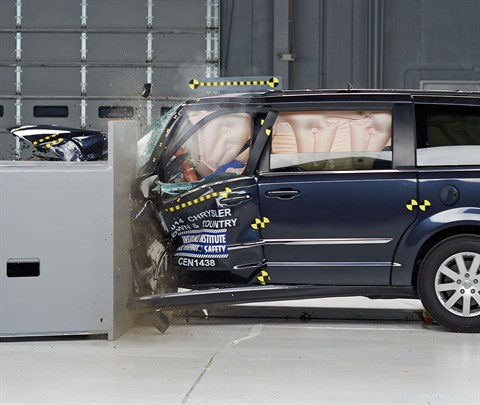
Action shot taken during the small overlap frontal crash test.
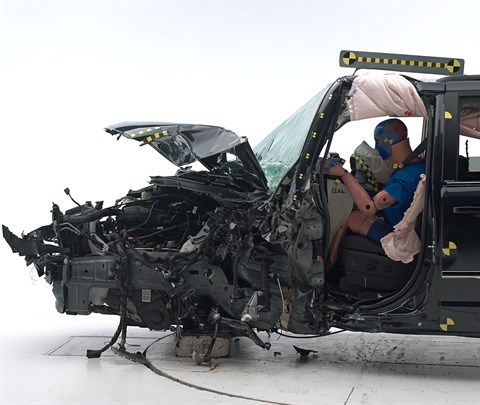
The dummy's position in relation to the door frame, steering wheel, and instrument panel after the crash test indicates that the driver's survival space was not maintained well.
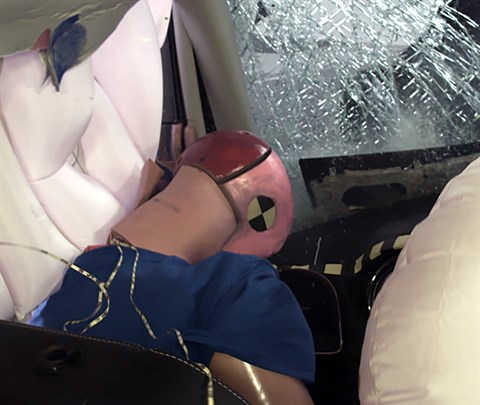
During the crash, the dummy's head barely contacted the airbag before sliding off to the left as the steering column moved to the right, and the head hit the instrument panel.

Door hinge pillar, parking brake, and instrument panel intrusion was extensive and contributed to a high risk of injuries to the left hip, left knee, and left lower leg and a moderate risk to the right lower leg. The parking brake pedal was deeply embedded in the dummy's lower leg skin.
Moderate overlap front: original test
Rating applies to 2008-20 models
Tested vehicle: 2008 Dodge Grand Caravan SXT
The Dodge Grand Caravan and Chrysler Town and Country were redesigned for the 2008 model year, and the Volkswagen Routan was introduced in the 2009 model year and discontinued after the 2012 model year. The Chrysler Town and Country was discontinued after the 2016 model year.
| Evaluation criteria | Rating |
|---|---|
| Overall evaluation | |
| Structure and safety cage | |
| Driver injury measures | |
| Head/neck | |
| Chest | |
| Leg/foot, left | |
| Leg/foot, right | |
| Driver restraints and dummy kinematics | |
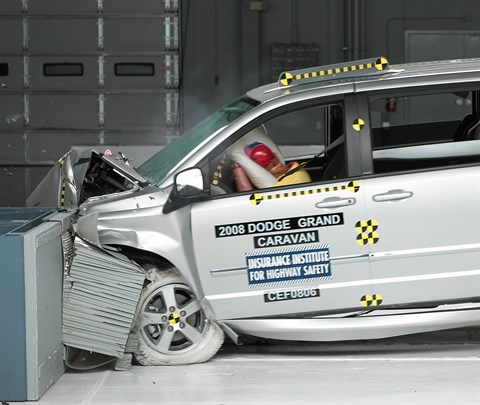
Action shot taken during the frontal offset crash test.
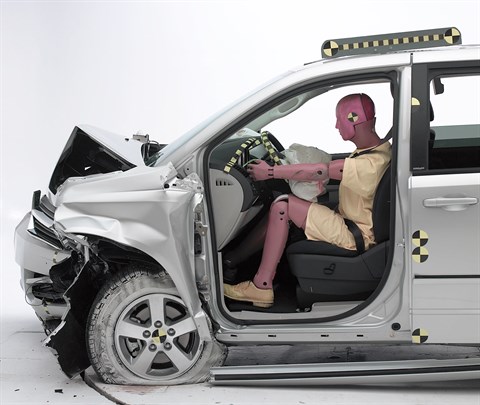
The dummy's position in relation to the steering wheel and instrument panel after the crash test indicates that the driver's survival space was maintained well.
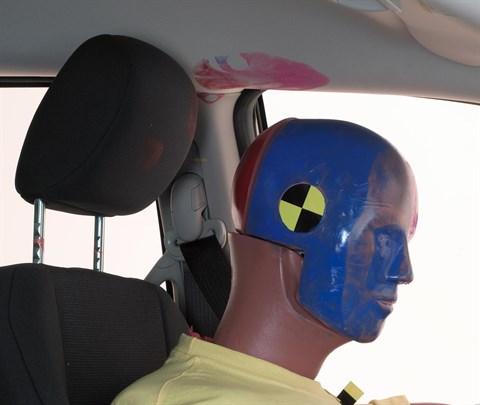
Smeared greasepaint indicates where the dummy's head hit the roof rail and B-pillar during rebound. Head acceleration from this hit was low.
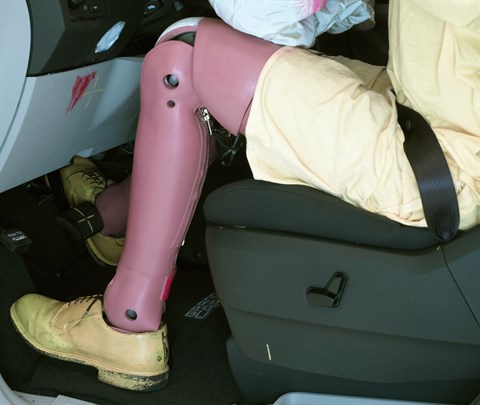
Intrusion into the driver's space was minimal, and all leg and foot injury measures were low.
Side: original test
Rating applies to 2011-20 models
Tested vehicle: 2012 Chrysler Town & Country Touring with head curtain airbags for all three rows of seats and front seat-mounted torso airbags
The Dodge Grand Caravan and Chrysler Town and Country were redesigned for the 2008 model year, and the Volkswagen Routan was introduced in the 2009 model year. Beginning with the 2011 models, side airbags designed to protect drivers' and front passengers' torsos were added to the side curtain airbags that were already standard on 2008-10 models. The Routan was discontinued after the 2012 model year and the Town and Country after the 2016 model year.
Two tests of the vans were conducted, one by the Institute in 2008 and the other by Chrysler in 2012. The vehicles are rated separately, except that structure ratings for the vehicles are based on both tests, as are the rear passenger injury and head protection ratings.
| Evaluation criteria | Rating |
|---|---|
| Overall evaluation | |
| Structure and safety cage | |
| Driver injury measures | |
| Head/neck | |
| Torso | |
| Pelvis/leg | |
| Driver head protection | |
| Rear passenger injury measures | |
| Head/neck | |
| Torso | |
| Pelvis/leg | |
| Rear passenger head protection | |
Roof strength
Rating applies to 2012-20 models
Tested vehicle: 2012 Chrysler Town & Country Touring
| Overall evaluation | |
|---|---|
| Curb weight | 4,594 lbs |
| Peak force | 20,717 lbs |
| Strength-to-weight ratio | 4.51 |
Head restraints & seats
Seat type: Power cloth seats with manual lumbar AHR built. after March 2010
| Overall evaluation | |
|---|---|
| Dynamic rating | |
| Seat/head restraint geometry |
About the head restraint & seat test
Currently, IIHS tests apply only to front seats.
Headlights
Trim level(s)
- All trims
| Evaluation criteria | Rating |
|---|---|
| Low-beam headlight type | Halogen reflector |
| High-beam headlight type | Halogen reflector |
| Curve-adaptive? | No |
| High-beam assist? | No |
|
Overall rating | |
| Distance at which headlights provide at least 5 lux illumination: | |
Low beams
On the straightaway, visibility was inadequate on both sides of the road. On curves, visibility was inadequate in all 4 tests.
The low beams never exceeded glare limits.
High beams
On the straightaway, visibility was inadequate on both sides of the road. On curves, visibility was inadequate in all 4 tests.
Child seat anchors
Rating applies to 2015-20 models
| Evaluation criteria | Rating |
|---|---|
| Overall evaluation | |
| Vehicle trim | American Value Package |
| Seat type | cloth |
This vehicle has 3 rear seating positions with complete child seat attachment (LATCH) hardware.
| Evaluation criteria | Rating |
|---|---|
| Overall evaluation | |
| Vehicle trim | American Value Package |
| Seat type | cloth |
| Rating icon | Rating |
|---|---|
| G | Good |
| A | Acceptable |
| M | Marginal |
| P | Poor |
| Seating positions that rely on borrowed lower anchors or have only a tether anchor available are not rated. | |
thether anchor symbol | Tether anchor |
lower anchor symbol | Lower anchors |
| Lower anchor(s) can be borrowed from adjacent positions(s) | |
| No hardware available |
Details by seating position
| Position | Rating |
|---|---|
| 2 | |
| Tether anchor | |
| hard-to-find location | |
| no other hardware could be confused for anchor | |
| Lower anchors | |
| too deep in seat | |
| not too much force needed to attach | |
| easy to maneuver around anchors | |
| 3 | |
| Tether anchor | |
| hard-to-find location | |
| no other hardware could be confused for anchor | |
| Lower anchors | |
| too deep in seat | |
| not too much force needed to attach | |
| easy to maneuver around anchors | |
| 5 | |
| Tether anchor | |
| hard-to-find location | |
| no other hardware could be confused for anchor | |
| Lower anchors | |
| not too deep in seat | |
| not too much force needed to attach | |
| easy to maneuver around anchors |
